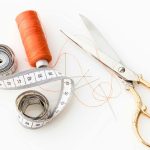You can improve your garden by using coconut landscape fabric, which controls weeds naturally while letting water and nutrients reach your plants. Choose from woven, non-woven, or needle-punched types based on your garden’s needs, and pick the thickness that suits your space. Prepare your bed by clearing debris, then lay and secure the fabric before planting. Maintaining it helps prolong its life and supports eco-friendly gardening. Keep exploring to find expert installation tips and care advice.
Table of Contents
Key Takeaways
- Choose the right type and thickness of coconut fabric based on garden needs for durability and breathability.
- Prepare the garden bed by clearing vegetation, debris, and leveling soil for smooth fabric installation.
- Lay the fabric with overlaps, secure with staples every 12 inches, and cut X-shaped slits for planting.
- Cover fabric with mulch or soil to enhance weed control and moisture retention.
- Maintain by checking fabric condition regularly, replenishing soil nutrients, and composting old fabric sustainably.
Benefits of Coconut Landscape Fabric
Although many garden fabrics are available, coconut landscape fabric stands out because it offers natural durability and excellent weed control, helping you maintain a healthy garden with less effort.
You’ll appreciate its eco-friendly nature since it’s made from renewable coconut fibers, reducing your environmental footprint. It’s also highly breathable, allowing water and nutrients to reach your plants without trapping moisture, which prevents root rot.
When you use this fabric, you’ll notice it breaks down slowly over time, adding organic matter back into your soil. Plus, its natural texture resists tearing better than synthetic alternatives, so you don’t have to replace it often.
Types of Coconut Landscape Fabric Available
You’ll find three main types of coconut landscape fabric to suit different gardening needs: woven, non-woven, and needle-punched.
Each type offers unique benefits depending on your garden’s requirements.
1. Woven Fabric: Made by weaving coconut fibers together, this fabric is durable and provides excellent weed control while allowing water and air to pass through.
It’s ideal for high-traffic areas.
2. Non-Woven Fabric: This type is bonded rather than woven, creating a softer, more flexible fabric.
It’s great for delicate plants and areas needing gentle soil protection.
3. Needle-Punched Fabric: Created by punching fibers to interlock them, this fabric offers superior strength and water permeability, perfect for heavy-duty gardening and erosion control.
Choosing among these options will help you tailor your garden fabric to your specific needs.
How to Choose the Right Coconut Fabric for Your Garden
When choosing coconut fabric for your garden, focus on thickness and durability to guarantee it stands up to wear and tear.
You’ll also want to take into account breathability and water flow to keep your plants healthy.
Picking the right balance will help your garden thrive.
Fabric Thickness and Durability
Thickness plays an essential role in determining the durability and effectiveness of coconut landscape fabric in your garden.
Choosing the right thickness guarantees your fabric withstands wear and tear while providing long-lasting support for your plants. Here’s what to take into account:
- Lightweight (1-2 mm): Ideal for small gardens or temporary use, but less durable against heavy foot traffic or weather.
- Medium (3-4 mm): Offers a balance of strength and flexibility, suitable for most garden applications.
- Heavyweight (5 mm and above): Best for high-traffic areas or slopes, providing maximum durability and resistance to tearing.
Selecting the appropriate thickness helps maintain soil stability and reduces replacement frequency, saving you time and effort in garden upkeep.
Breathability and Water Flow
Since proper breathability and water flow are vital for healthy plant growth, choosing coconut landscape fabric that allows air and moisture to pass through efficiently is important.
You want a fabric that doesn’t trap water or suffocate roots. Look for loosely woven or perforated coconut fibers, which guarantee water drains well and air circulates freely. This prevents root rot and promotes oxygen exchange, helping your plants thrive.
Avoid overly dense or thick fabrics that block moisture or restrict airflow. Also, consider your garden’s watering habits and soil type—well-draining soils pair best with fabrics that support quick water flow.
Preparing Your Garden Bed for Installation
Before laying your coconut landscape fabric, clear all existing vegetation from the garden bed.
Next, level and smooth the soil to create an even surface.
Finally, mark the bed boundaries to keep everything neat and organized during installation.
Clear Existing Vegetation
Start by removing all existing vegetation from your garden bed to guarantee the coconut landscape fabric lays flat and functions effectively.
Clearing out weeds, grass, and old plants prevents bumps and holes that could reduce the fabric’s durability.
Here’s how to do it efficiently:
- Pull Weeds and Dead Plants – Remove roots to stop regrowth.
- Use a Garden Hoe or Trowel – Dig out stubborn roots and debris.
- Dispose of the Vegetation Properly – Compost healthy plants or discard weeds to avoid spreading seeds.
Level and Smooth Soil
To prepare your garden bed for installing coconut landscape fabric, you’ll want to level and smooth the soil thoroughly.
Start by removing any large rocks, roots, or debris that could create bumps under the fabric. Use a rake to break up clumps and distribute soil evenly across the area.
If the soil is compacted, loosen it with a garden fork or tiller to improve drainage and root growth. Aim for a flat, even surface to guarantee the fabric lies smoothly without wrinkles or gaps, which can allow weeds to sneak through.
Taking the time to create a well-prepared bed will help the coconut fabric perform better, extending its lifespan and effectiveness in your garden.
Mark Garden Bed Boundaries
Once your soil is level and smooth, defining the exact boundaries of your garden bed guarantees the coconut landscape fabric fits perfectly.
Clear boundaries prevent fabric overlap or gaps that let weeds sneak through. Here’s how to mark your garden bed boundaries efficiently:
- Use wooden or metal stakes at each corner to outline the bed shape.
- Stretch string or twine tightly between stakes for a clear, straight edge.
- Trace along the string with a garden hose, spray paint, or a hand trowel to create a visible line.
Step-by-Step Guide to Installing Coconut Landscape Fabric
Installing coconut landscape fabric involves a few straightforward steps that you can easily follow to improve your garden’s weed control and soil health.
First, clear the area of debris, weeds, and rocks. Next, measure and cut the fabric to fit your garden bed, allowing some overlap at the edges.
Lay the fabric smoothly over the soil, ensuring it covers the entire bed. Secure the fabric with garden staples or pins spaced about 12 inches apart to prevent shifting.
If you’re planting through the fabric, cut small X-shaped slits at your desired planting spots. Finally, cover the fabric with mulch or soil to protect it from sun damage and enhance its effectiveness.
With these steps, your garden will stay tidy and healthy.
Tips for Maintaining Your Coconut Landscape Fabric
After setting up your coconut landscape fabric, keeping it in good condition helps maximize its benefits.
You want it to last and continue suppressing weeds while allowing water and air to reach your plants.
Here are three tips for maintaining your coconut landscape fabric:
- Check regularly for damage – Inspect the fabric every few weeks for tears or holes, and patch them promptly to prevent weeds from sneaking through.
- Keep the surface clear – Remove fallen leaves and debris to avoid mold growth and keep the fabric breathable.
- Secure edges firmly – Make sure the edges stay anchored with stakes or pins to prevent the fabric from shifting or lifting during strong winds.
Eco-Friendly Gardening Practices With Coconut Fabric
Because coconut landscape fabric is biodegradable and made from natural fibers, it fits perfectly into eco-friendly gardening practices.
When you use it, you reduce reliance on synthetic materials that harm the environment. It naturally suppresses weeds without chemicals, protecting your soil and beneficial insects.
Plus, as it breaks down, it enriches your garden bed with organic matter. You can compost old fabric pieces, closing the loop in your garden’s nutrient cycle.
Choosing coconut fabric also supports sustainable agriculture since coconuts are a renewable resource.
Frequently Asked Questions
Can Coconut Fabric Be Used for Indoor Plants?
You won’t find coconut fabric hosting a jungle party indoors, but you can use it to line pots or improve drainage. Just don’t expect it to replace your chic indoor planters or a stylish moss carpet!
How Does Coconut Fabric Compare to Synthetic Weed Barriers?
You’ll find coconut fabric is biodegradable and eco-friendly, unlike synthetic barriers that last longer but harm the environment. Coconut fabric lets water and air through, promoting healthy soil, while synthetics can trap moisture and cause root issues.
Is Coconut Landscape Fabric Safe for Pets?
You can feel safe using coconut landscape fabric around pets since it’s natural, biodegradable, and free from harmful chemicals. Just make certain your pets don’t chew on it excessively to avoid any minor digestive issues.
Can Coconut Fabric Be Reused After Removing It?
Like a well-worn blanket, coconut fabric can be reused if you carefully remove it without tearing. You’ll want to clean off soil and debris, then lay it back down gently to keep its durability intact.
Does Coconut Fabric Affect Soil Ph or Nutrient Levels?
Coconut fabric generally won’t affect your soil’s pH or nutrient levels greatly. It’s natural and biodegradable, so it breaks down slowly without releasing harmful chemicals or altering the soil’s balance, keeping your garden healthy.
- What Is Hydrophilic vs. Hydrophobic Nonwoven Fabric? - July 11, 2025
- Is Nonwoven Fabric Breathable? An Important Factor for Masks and Apparel - July 11, 2025
- How Nonwoven Technology Revolutionized the Diaper Industry - July 11, 2025







